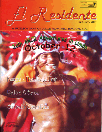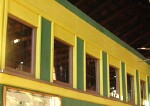 Feature Article
Feature Article
Articles from the Magazine El Residente published by ARCR Administracion SA
|
Articles from the Magazine El Residente published by ARCR Administracion SA | ||
The Jungle Train ! | |
|
By |
Toot, toot, toooooot, went the tired and rickety old train. ALL ABOARD, shouted the train's conductor. WANT TO COME ABOARD THE JUNGLE TRAIN? |

Sorry, you can't ride the train to Limon anymore. The extensive miles of iron tracks, on which the train potently ran at one time, fell into disrepair years ago. The Costa Rican government shut down the train in December of 1990 after one hundred years of service. The inclemency of our tropical rains, irregular topography and constant mudslides have prevented the famed jungle train from returning.
Gone are the sounds of tired engines and the creaking of wooden seats bolted in the old cars with windows that opened like the ones in public buses. Gone are the long whistles of engines that used to run a freight and passenger service between San Jos? and the Atlantic region of Costa Rica. And what an experience it was! I remembered how euphoric my sisters and I were the first time we visited the port city of Limon aboard the train.
For more than a century, the Port of Limon played a very important role in the export of coffee and bananas, two of Costa Rica's main export products since the early 1800s.

Then Limon, the warm, sultry Caribbean Coast community located in the East of Costa Rica, became a hot bed of activity when the Costa Rican government contracted an American entrepreneur to build Costa Rica's first railroad system. The project was of unprecedented magnitude for the country. The original purpose for the huge undertaking was to allow the export of coffee to Europe.
In those years the area was very inhospitable to newcomers. Very hot and humid conditions, lack of housing, doctors, stores; the spread of skin fungus and infectious diseases plus an abundance of malaria carrying mosquitoes were common. Thousands of workers from Jamaica were brought to the country to work on the railroad in the belief that they were physically built to withstand the rigorous weather conditions. But Blacks were not the only people who immigrated to Costa Rica in those years. Many Italian and Chinese workers were also recruited to work for the railroad. Today the population in the Port of Limon and its surrounding rural neighborhoods trace their roots back to the West Indies, Africa and China.

The year was 1884 and Minor C. Keith became the man in charge at the time. The Costa Rican government had run completely out of money by then and the railroad project had come to a complete standstill. Keith made a deal with then President Bernardo Soto. Keith ended up financing the railroad project in exchange for the 800,000 acres of unused land along the train tracks. The deal was worked out successfully when the Costa Rican government agreed to lease the land to Mr. Keith on a tax-free basis for a period of 99 years and finally, the railroad project started moving once again. All in all, construction of the railroad took nineteen years to be completed, claimed thousands of lives and ended up costing the existing government about 8 million dollars.
Taking advantage of the land lease, Mr. Keith with characteristic American savvy saw the opportunity to plant bananas throughout the lands running parallel to he railroad tracks. Costa Rica was in fact the first country that produced bananas in Central America. Growers of the fruit soon discovered that they had struck gold. From the humble Atlantic Coast of Costa Rica bananas were being exported to the United States and the banana industry became highly profitable.
Among them was the legendary United Fruit Company, injected at the time by foreign capital, had achieved the important status as the main banana producer in the world. It wasn't without setbacks though. Banana workers were experiencing at the time poor, dangerous working conditions, which ended in confrontation against the plantation owners. The first banana workers' strike in Costa Rica took place around the year 1920. Over the years, the banana blight afflicted crops in the Atlantic region and the banana operation was moved to the Pacific Region.
Then the train, which had been an essential part for ambitious infrastructure projects at the turn of the 19th century in this country, suffered a change of identity. After a few decades transporting coffee and bananas to and from former inaccessible places, putting Costa Rica in a much better economic position; it was put then put to the service of the public as a means of transportation.
The train to the Atlantic began transporting people from one rural settlement to the next; took local children to isolated schools and even served as a local ambulance when necessary. The train station to the Atlantic opened up in San Jose not too far from the National Park offering daily trips from San Jose to Limon and taking passengers several years ago I too was one of those passengers.

One of my clearest memories was arriving in the town of Siquirres about four hours after my journey began. In Siquirres, a large crowd of vendors prepared ahead of time delicious foods to peddle among the train passenger during the approximate 15 minutes the Siquirres stop took.
A swarm of barefoot children also waited for the train. Each child ran to the different cars carrying in their hands tin bowls filled with food of all types.
Hungry train riders splurged on fresh slices of watermelon, mangoes, mara-on fruit, roasted cashews, corn tortillas stuffed with meats and vegetables, breads, fresh juices and much more. The closer the train brought us to our destination the temperature began increasing. As the jungle train continued to put us deeper into the Atlantic zone, I could feel the lethargic sensation caused by the rising heat and humidity as we approached sea level.
Finally, after six long, exhausting hours on the train, I saw palm trees swaying calmly in the balmy breeze and I just knew we have finally reached the Atlantic Coast. The majestic blue waters of the Caribbean Sea came in full view. I can't think of enough words to describe the exhilaration I felt upon seeing those blue waters for the first time. There, in front of me, the sea stretched for miles upon miles and my first Caribbean journey on board the jungle train had ended.
Toward the end of its long service the train became a major tourist attraction for a short time only. It was during this sting in the tourism industry that it was dubbed with the named of " the jungle train." Those of us who rode the venerable train to the Atlantic Coast like to think of it as the old "iron icon" which forever changed our lives.
© El Residente ARCR Administración S.A. San José, Costa Rica N.B. Like all information on the internet, this article may currently be incorrect or out of date.